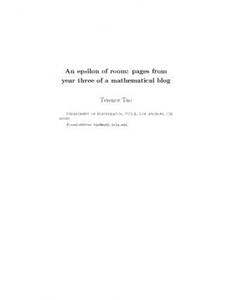Table Of ContentAn epsilon of room: pages from
year three of a mathematical blog
Terence Tao
Department of Mathematics, UCLA, Los Angeles, CA
90095
E-mail address: [email protected]
To Garth Gaudry, who set me on the road;
To my family, for their constant support;
And to the readers of my blog, for their feedback and contributions.
Contents
Preface xi
A remark on notation xii
Acknowledgments xiii
Chapter 1. Real analysis 1
§1.1. A quick review of measure and integration theory 2
§1.2. Signed measures and the Radon-Nikodym-Lebesgue
theorem 13
§1.3. Lp spaces 26
§1.4. Hilbert spaces 46
§1.5. Duality and the Hahn-Banach theorem 62
§1.6. A quick review of point set topology 76
§1.7. The Baire category theorem and its Banach space
consequences 91
§1.8. Compactness in topological spaces 109
§1.9. The strong and weak topologies 128
§1.10. Continuous functions on locally compact Hausdorff
spaces 146
§1.11. Interpolation of Lp spaces 175
§1.12. The Fourier transform 205
vii
viii Contents
§1.13. Distributions 238
§1.14. Sobolev spaces 266
§1.15. Hausdorff dimension 290
Chapter 2. Related articles 313
§2.1. An alternate approach to the Carath´eodory extension
theorem 314
§2.2. Amenability, the ping-pong lemma, and the Banach-
Tarski paradox 318
§2.3. TheStoneandLoomis-Sikorskirepresentationtheorems331
§2.4. Well-ordered sets, ordinals, and Zorn’s lemma 340
§2.5. Compactification and metrisation 352
§2.6. Hardy’s uncertainty principle 357
§2.7. Create an epsilon of room 363
§2.8. Amenability 373
Chapter 3. Expository articles 381
§3.1. An explicitly solvable nonlinear wave equation 382
§3.2. Infinite fields, finite fields, and the Ax-Grothendieck
theorem 388
§3.3. Sailing into the wind, or faster than the wind 395
§3.4. The completeness and compactness theorems of
first-order logic 404
§3.5. Talagrand’s concentration inequality 423
§3.6. The Szemer´edi-Trotter theorem and the cell
decomposition 430
§3.7. Benford’s law, Zipf’s law, and the Pareto distribution 438
§3.8. Selberg’s limit theorem for the Riemann zeta function
on the critical line 450
§3.9. P =NP, relativisation, and multiple choice exams 460
§3.10. Moser’s entropy compression argument 467
§3.11. The AKS primality test 478
§3.12. Theprimenumbertheoreminarithmeticprogressions,
and dueling conspiracies 483
Contents ix
§3.13. Mazur’s swindle 505
§3.14. Grothendieck’s definition of a group 508
§3.15. The “no self-defeating object” argument 518
§3.16. From Bose-Einstein condensates to the nonlinear
Schr¨odinger equation 535
Chapter 4. Technical articles 549
§4.1. Polymath1 and three new proofs of the density
Hales-Jewett theorem 550
§4.2. Szemer´edi’s regularity lemma via random partitions 565
§4.3. Szemer´edi’s regularity lemma via the correspondence
principle 574
§4.4. The two-ends reduction for the Kakeya maximal
conjecture 585
§4.5. The least quadratic nonresidue, and the square root
barrier 592
§4.6. Determinantal processes 605
§4.7. The Cohen-Lenstra distribution 619
§4.8. An entropy Plu¨nnecke-Ruzsa inequality 624
§4.9. An elementary noncommutative Freiman theorem 627
§4.10. Nonstandard analogues of energy and density
increment arguments 631
§4.11. Approximate bases, sunflowers, and nonstandard
analysis 635
§4.12. The double Duhamel trick and the in/out
decomposition 656
§4.13. The free nilpotent group 660
Bibliography 669
Preface
In February of 2007, I converted my “What’s new” web page of re-
search updates into a blog at terrytao.wordpress.com. This blog
has since grown and evolved to cover a wide variety of mathematical
topics, ranging from my own research updates, to lectures and guest
posts by other mathematicians, to open problems, to class lecture
notes, to expository articles at both basic and advanced levels.
Withtheencouragementofmyblogreaders,andalsooftheAMS,
Ipublishedmanyofthemathematicalarticlesfromthefirsttwoyears
of the blog as [Ta2008] and [Ta2009], which will henceforth be re-
ferredtoasStructure and Randomness andPoincar´e’s Legacies Vols.
I, II throughoutthisbook. Thisgavemetheopportunitytoimprove
and update these articles to a publishable (and citeable) standard,
andalsotorecordsomeofthesubstantivefeedbackIhadreceivedon
these articles by the readers of the blog.
The current text contain many (though not all) of the posts for
the third year (2009) of the blog, focusing primarily on those posts
of a mathematical nature which were not contributed primarily by
other authors, and which are not published elsewhere.
This year, over half of the material consists of lecture notes from
my graduate real analysis courses that I taught at UCLA (Chapter
1), together with some related material in Chapter 2. These notes
cover the second part of the graduate real analysis sequence here,
xi
xii Preface
and therefore assume some familiarity with general measure theory
(inparticular,theconstructionofLebesguemeasureandtheLebesgue
integral, and more generally the material reviewed in Section 1.1), as
well as undergraduate real analysis (e.g. various notions of limits
and convergence). The notes then cover more advanced topics in
measure theory (notably, the Lebesgue-Radon-Nikodym and Riesz
representation theorems), as well as a number of topics in functional
analysis, such as the theory of Hilbert and Banach spaces, and the
studyofkeyfunctionspacessuchastheLebesgueandSobolevspaces,
orspacesofdistributions. ThegeneraltheoryoftheFouriertransform
is also discussed. In addition, a number of auxiliary (but optional)
topics, such as Zorn’s lemma, are discussed in Chapter 2. In my
own course, I covered the material in Chapter 1 only, and also used
Folland’s text [Fo2000] as a secondary source; but I hope that this
textmaybeusefulinothergraduaterealanalysiscourses,particularly
in conjunction with a secondary text (in particular, one that covers
the prerequisite material on measure theory).
The rest of this text consists of sundry articles on a variety of
mathematicaltopics,whichIhavedivided(somewhatarbitrarily)into
expositoryarticles(Chapter3)whichareintroductoryarticlesontop-
ics of relatively broad interest, and more technical articles (Chapter
4) which are narrower in scope, and often related to one of my cur-
rentresearchinterests. Thesecanbereadinanyorder,althoughthey
often reference each other, as well as articles from previous volumes
in this series.
A remark on notation
For reasons of space, we will not be able to define every single math-
ematical term that we use in this book. If a term is italicised for
reasons other than emphasis or for definition, then it denotes a stan-
dard mathematical object, result, or concept, which can be easily
looked up in any number of references. (In the blog version of the
book, many of these terms were linked to their Wikipedia pages, or
other on-line reference pages.)
I will however mention a few notational conventions that I will
use throughout. The cardinality of a finite set E will be denoted

